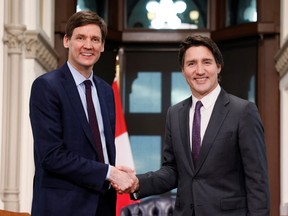No quantity of federal money will completely repair this mess. The premiers should be keen to discover new methods to revive the affected person.

Article content material
Who can neglect Paul Martin’s passionate 2004 pledge that he would repair well being care “for a technology” along with his $41-billion transfer-payment enhance to the provinces? Why, simply have a look at what nice form well being care is in at the moment!
Commercial 2
Article content material
Oh, you’re not satisfied? These lengthy ER waits, your lacking household physician and the problem in acquiring routine checks have left you exhausted and pissed off? Inside and outdoors the health-care group, individuals really feel your ache.
Article content material
The query, although, is to what extent one other big federal injection of money will really alleviate the struggling.
When the prime minister and the premiers meet on Tuesday, they’ll focus on how a lot new — and what quantity — of well being funding ought to come from the federal authorities. The premiers need the federal share upped to 35 per cent of health-care prices; the feds at the moment cowl 22 per cent. In the meantime Prime Minister Justin Trudeau, having discovered a factor or two from previous negotiations, desires situations on the money: a concentrate on improved surgical procedure wait instances, major care, psychological well being and long-term care properties. The feds additionally need correct data-gathering; it might be useful to know if these transferred tax {dollars} really make a distinction.
Commercial 3
Article content material
All nicely and high quality. However provinces can’t merely lay their health-care woes on the ft of the federal authorities. Whereas the COVID-19 disaster uncovered the fragility of care throughout sectors — the outrageous situations in long-term care, as an example — such considerations have existed for years. Federal money has by no means “fastened” these issues, not to mention “for a technology.” Certainly, in some circumstances it might have had the alternative influence: permitting provincial governments a reprieve from embracing long-term options for his or her ailing and sclerotic health-care programs.
In actual fact, it took the COVID disaster to really spur a trickle of innovation. In Ontario, whereas the Ford authorities has pledged new hospitals and long-term care beds, it has additionally taken child steps into different types of well being supply. It lately introduced plans to supply OHIP-covered cataract, hip and joint-replacement surgical procedure outdoors hospitals. Ontario pharmacies at the moment are in a position to prescribe for 13 routine illnesses. New approaches to recruiting nurses and medical doctors are underway.
Commercial 4
Article content material
That’s simply Ontario. Different provinces are additionally dabbling in contemporary concepts. Every will (hopefully) study from the expertise of the others.
What in addition they should study is that whereas federal cash may be very good (and the feds make handy scapegoats when one thing goes awry), no quantity from the federal treasury will remedy all health-care issues. A willingness to discover completely different supply strategies — sure, a few of them involving the personal sector — is the one path to bettering care.
For this technology — and the subsequent.
-

Kurl: Enjoying health-care hero might be tough for the premiers and the PM
-

VanderBent: Residence-care focus could make new federal well being funding go additional

